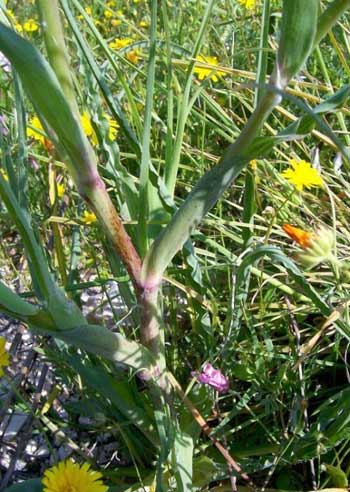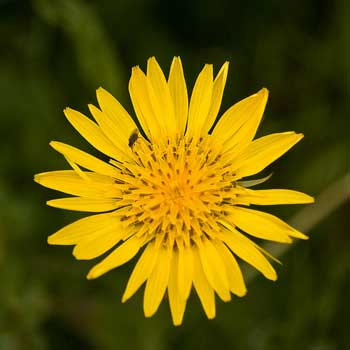Contents:
Common Names | Parts Usually Used | Plant(s) & Culture | Where Found | Medicinal Properties
Legends, Myths and Stories | Uses | Formulas or Dosages | Nutrient Content | How Sold | Warning | Bibliography
Scientific Names

- Tragopogon pratensis L.
- Compositae
- Composite family
Common Names
- Meadow salsify
- Noonday flower
- Noon flower
- Noontide
- Star of Jerusalem
- Yellow goatsbeard
Parts Usually Used
Root
Back to Top

Description of Plant(s) and Culture
Yellow goatsbeard is a biennial or perennial plant; the slender, fleshy taproot produces a light green, succulant stem from 1-3 feet high, containing a bitter milky juice. The alternate, grasslike, clasping leaves have curled margins and taper to long pointed, backward-bending tips. The stem bears a solitary yellow flower head with ray flowers that unfold early in the morning and close up at midday.
Other varieties: Purple goatsbeard or salsify (T. porrifolius) is a related larger species with uncurled leaves and purple flowers. It is perhaps more widespread than yellow goatsbeard, since it is often cultivated for its edible, oyster-flavored root. The root also has some diuretic properties, but they are weaker than those of yellow goatsbeard.
Aruncus dioicus is also called goat’s beard.
Back to Top
Where Found
Grows in pastures, fields, meadows, and waste places of Europe, from where it has come to be naturalized in southern Canada and the northern part of the United States.
Back to Top
Medicinal Properties
Diuretic, stomachic
Back to Top
Legends, Myths and Stories
There is another herb that is called goat’s beard (Aruncus dioicus) of the Rose family. Other than having yellow flowers, this herb has no similarity with Yellow goatsbeard (Tragopogon pratensis) or Salsify (Tragopogon porrifolius).
Salsify (T. porrifolius) is sometimes spelled “salsafy”. Grown as a potherb for its roots. Harvested, stored and cooked much as carrots or beets. Salsify or oyster-plant, yields a juice, that when chewed is said to aid digestion.
Back to Top
Uses
Primarily used as a remedy for urinary and water-retention problems, the root decoction has been used for lack of appetite, heartburn, and digestive difficulties.
Back to Top
Bibliography
![]() The Herb Book
The Herb Book, by John Lust, Bantam Books, 666 Fifth Avenue, New York, NY. copyright 1974.
![]() The Nature Doctor: A Manual of Traditional and Complementary Medicine
The Nature Doctor: A Manual of Traditional and Complementary Medicine, by Dr. H.C.A. Vogel; Keats Publishing, Inc., 27 Pine Street (Box 876) New Canaan, CT. 06840-0876. Copyright Verlag A. Vogel, Teufen (AR) Switzerland 1952, 1991
![]() Eastern/Central Medicinal Plants
Eastern/Central Medicinal Plants, by Steven Foster and James A. Duke., Houghton Mifflin Company, 215 Park Avenue South, New York, NY 10000
![]() Webster’s New World Dictionary
Webster’s New World Dictionary, Third College Edition, Victoria Neufeldt, Editor in Chief, New World Dictionaries: A Division of Simon & Schuster, Inc., 15 Columbus Circle, New York, NY 10023
 The Rodale Herb Book: How to Use, Grow, and Buy Nature’s Miracle Plants (An Organic gardening and farming book)
The Rodale Herb Book: How to Use, Grow, and Buy Nature’s Miracle Plants (An Organic gardening and farming book), edited by William H. Hylton, Rodale Press, Inc. Emmaus, PA, 18049., 1974
